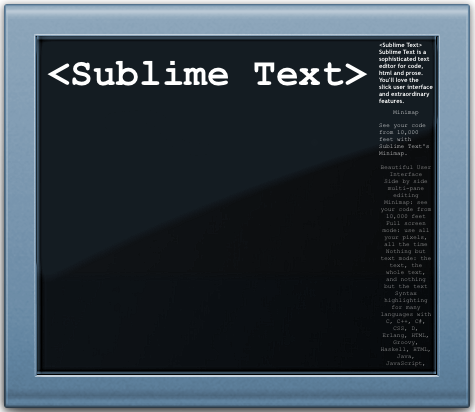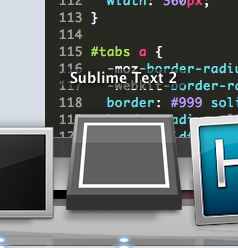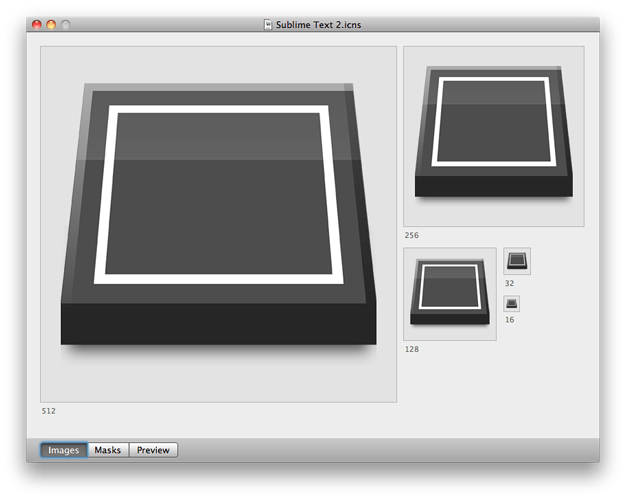Thanks for the hi-res icon!
New logo discussion?
I just don’t understand why you would emphatically state that icons shouldn’t be literal to later go on and say that, literal icons can be ok. Perhaps later on you’ll decide literal icons can be just as good as non-literal ones and then maybe decide literal icons are the best. How am I supposed to take what you’re saying seriously when you’re constantly changing you’re stance.
It really isn’t. The first paragraph of your argument was as follows. Icons should not be literal (which you later amended which doesn’t really make your argument any stronger if you’re going to be constantly changing your stance). Then you went on to list several icons that you considered to be successful non-literal icons. What conclusion do you expect someone to draw from that? I’d argue the only rational conclusion to draw from that would be that icons shouldn’t be literal because there are successful non-literal ones.
I was reiterating my previous statement for clarity.
You seem to be plucking bits of my argument out in support of your own and not taking the whole thing into account. To put things simply so that you don’t misunderstand me, the vast majority of icons are not literal, they are abstract. Most successful icons are abstract and do not literally represent what the application does. This is a basic principle we learn at design school in logo and branding classes. It’s been over 10 years since I was at design school, but the principle hasn’t changed. I’m not just making this stuff up.
For the same reason I felt you didn’t need to list a handful of what you perceived to be successful non-literal icons that nearly every computer user sees on a daily basis. Do you need me to list some successful literal icons?
I’m really not. You’re stating the same thing over and over and it’s the exact thing I’m describing. You are not actually giving reasons for why a non-literal icon is better than a literal one. The only reason you’ve supplied for them being better is that you know of more successful abstract ones than literal ones. What exactly are the criteria you are requiring for an icon to be considered “successful”? To be honest, you’ve yet to actually supply a real argument. You have merely been stating a personal opinion.
What body of evidence would that be? Perhaps this is all hinging on your definition of literal? Icons and logos can be literal in different senses. A bottle is not the only way for a Pepsi logo to be literal. YouTube, NFL, and perhaps even to the degree of Twitter’s silhouette of a bird could all be considered rather literal. Non-literal, abstract icons and logos would be that of the likes of Pepsi and Chase Bank. You’ll actually find “non-literal” and abstract icons / logos are quite in the minority.
A blank slate suits many things. It’s a blank slate. It’s the base of many things, hence why it makes a bad icon. It could be alluding to a number of things.
I made a mistake which I corrected in order to clarify what I am saying. I’m only human and I’m sure I’m not the only one to be imprecise in my language. I didn’t mean to emphatically state that icons should never be literal. I’m not constantly changing my stance - that’s an exaggeration, hyperbole. My stance is clear.
You invented two sentences and actually quoted me on them and now also made an exaggeration. That really is a straw man argument. Given that my first sentence was at first imprecise, for which I apologise, I can see how you drew your conclusion initially. It’s no big deal, just a misunderstanding because of my imprecise language. My bad. But I did clarify what I was trying to convey and you’ve continued to attack me on my first faulty, but now corrected, sentence. It feels like you’re ignoring what I’m actually saying just so you can declare victory rather than reach an amicable understanding. If victory means so much to you, please do accept it with my best wishes. Maybe we need some debate victory medals on this forum? 
Let me break down what I am saying so that there can be no misunderstanding:
My assertion: Icons should not necessarily be literal
My evidence: Most successful icons are not literal
My conclusion: Therefore the Sublime icon does not need to be literal in order to be successful
Clear?
You could do, and it would certainly strengthen your argument. Why have you not? Because it’s hard to find good literal icons perhaps? I’ll help you out if you like: OS X has some notable literal icons such as iCal, Address Book and iPhoto. Obviously listing a few decent literal icons wouldn’t prove your point unless you could gather a list of all literal icons and compare them to a list of all non-literal. What we can do is look at our own task bars or start menus or docks or whatever and get a rough idea of the ratio of literal to non-literal icons. I invite you to do that. I am saying that most icons are non-literal in my task bar and start menu. I am saying most well known recognisable and therefore successful icons are non-literal. I am saying that Sublime’s icon does not need to be made more literal. You say it needs to be more distinct by making it more literal. I say if Jon wants to make it more distinct, he doesn’t need to make it more literal.
Non-literal is not necessarily better, but it gives you a greater amount of flexibility when trying to convey all of the fuzzy stuff encapsulating a brand. More flexibility is better. Tell me why the Sublime icon needs to be more literal in order to make it distinct.
You are stating your personal opinion too, that the Sublime icon should be made more distinct by making it more literal - you’re saying we should be able to “tell Sublime’s purpose from it’s icon.” If you knock out “purpose” from that sentence, we’d be in agreement.
The criterion I have for judging an icon to be successful is the body of icons and logos and brands I see around me and making a judgement call on which are successful based on whether the company or product is successful. Is that not reasonable?
The body of icons and logos and brands all around us. Maybe you see the world differently but I perceive there to be more abstract icons than literal ones from which I infer that abstract tends to be more successful.
Maybe it is hinging on both of our definitions of literal? My definition is in the traditional sense: non-abstract, factual, avoiding metaphor, non-figurative. What is yours?
The Pepsi logo is not a bottle (that would be one of Coke’s branding styles); the Pepsi logo is entirely abstract and non-literal.
I see what you’re getting at, but only the NFL logo is really anything like literal. YouTube uses metaphor: a red bezelled rectangle that is suggestive of old-style TVs. That’s not a literal rendering of online video. Twitter uses the metaphor of a bird (which twitters) and is therefore non-literal. If Twitter were a site about birds, then it would be close to literal. But Twitter isn’t a site about birds, which makes the logo non-literal. See what I mean?
Take a look through a logo/branding/icon gallery site and see how many are non-literal vs literal. The statement “You’ll actually find “non-literal” and abstract icons / logos are quite in the minority.” is factually and demonstrably incorrect. Try here for instance: underconsideration.com/brandnew/
I think what you’re saying is that some logos have some element representing a sort of stylized literal rendering of a real-life object or product or organization. That’s a fair observation. But it doesn’t detract from the idea that logos don’t need to be literal and that most, in fact, are not literal and therefore Sublime’s does not need to be literal either.
Your opinion is that icons are better if they’re more literal and yet you’ve given nothing to support your claim. My opinion is that icons aren’t necessarily better if they’re more literal and have given plenty in support of my claim. Your opinion is that it’s a bad icon because it’s not distinct enough and would be improved by making it more literal. My opinion is that it’s a pretty good icon and doesn’t need to be made more literal, although it might be improved by making it more distinct. Perhaps we’re both right. This isn’t a binary issue. Icons don’t need to be either absolutely literal or absolutely abstract and neither of us is arguing that. Either way, I think Jon should spend his efforts elsewhere. As should we. 
How about something like this?
https://img.skitch.com/20110210-bypcpe943t77beh9nemj9j5dfj.jpg
A pretty rough sketch but you get the idea.
It was an exaggeration to make a point.
I never stated that you in fact said those sentences. I stated that what you said was equatable to those sentences and was what they were implying. The majority of my previous post actually had nothing to do with your previous correction. It would seem you are ignoring what I am saying? Or perhaps responding to it in part and not as a whole? You clearly read my entire post so I don’t see why you would state that I am only attacking you on that one point when as I said the majority of my previous post had nothing to do with it.
[quote=“charlesroper”]Let me break down what I am saying so that there can be no misunderstanding:
My assertion: Icons should not necessarily be literal
My evidence: Most successful icons are not literal
My conclusion: Therefore the Sublime icon does not need to be literal in order to be successful
Clear?[/quote]
Perhaps the rift between our stances is due to your conclusion? I see no point in doing anything in this world unless your goal is to make it the best. Obviously this isn’t always a realistic or attainable goal but it should always be THE goal, in my opinion. Making an icon that’s just successful really doesn’t register with me. That’s like making something and saying: Oh hey, it works, good enough! For me it should always be: Oh hey, it works! Now how to make it better?
It really isn’t to me based on what I consider literal. I’d consider most of the icons in my bookmark toolbar to be literal.
To further clarify I said Sublime’s icon needs to be more distinct and I’d prefer this being accomplished by making it more literal. The main point being that the icon needs to be more distinct whether it’s in a way that is preferable to me or not.
Your first statement hinges very heavily on what you’d consider to be literal. Sure abstract may be more flexible, but having a completely abstract icon can really backfire when no one can place what that icon or logo belongs too. I’d argue an abstract icon would only be possible if you have the means and audience to push that icon being yours. Or if simply it being recognizable is of no importance to you.
Again, I stated this above, in my last post, and I believe in the one before that. I said I only preferred that it becomes more distinct by way of becoming more literal. The main point was that it needs to be more distinct and I supplied the way I would prefer this being accomplished.
[quote=“charlesroper”]You are stating your personal opinion too, that the Sublime icon should be made more distinct by making it more literal - you’re saying we should be able to “tell Sublime’s purpose from it’s icon.” If you knock out “purpose” from that sentence, we’d be in agreement.
The criterion I have for judging an icon to be successful is the body of icons and logos and brands I see around me and making a judgement call on which are successful based on whether the company or product is successful. Is that not reasonable?[/quote]
I never stated my argument was fact. The above was merely in response to your claim “I’m not making this stuff up” and attempts of passing off everything you were stating as fact. I’m saying: "You should be able to tell Sublime’s icon is Sublime’s icon and it should never be possible in any situation to be confused for another apps icon."
I suppose your criterion is passable although it gets very fuzzy based on what sense you’re considering something to be successful. You may consider Sublime to be successful but in the scheme of things it really isn’t. I believe it has the capability to be, but there is nearly 0 word-of-mouth and absolutely no marketing behind it. You ask 10 people what their text editor of choice is likely 0 will name Sublime. Out of 100, maybe 5? And that’s probably being generous. Sure 5 might be better than a lot of other editors, but editors are a dime a dozen and while it might be more successful than those that doesn’t make it successful in the scheme of things.
Again, this is all down to our interpretations of literal and abstract when it comes to icons and logos.
Literal in the sense of pertaining to it’s use or name. The NFL logo is literal, it is made up of the letters “N”, “F”, and “L”. CloudApp’s icon is literal. It’s icon is a cloud. GiantBomb’s icon is literal. It’s a giant bomb. GMail’s icon is literal. It’s icon is an envelope. YouTube’s icon is literal. It’s icon is made up of the words “You” and “Tube”.
An abstract icon is one that is in no way associative in any form to what it belongs to. Chase Bank’s logo to me is the perfect example of abstract.
I know it’s not a bottle. I even state later on that it’s a good example of an abstract logo -_- My point was if you wanted to create a literal Pepsi logo, a bottle is not the only way to accomplish this. A logo containing simply the word “Pepsi” would be a literal logo.
Have you ever tried searching for “metaphorical icons”. If you asked someone if YouTube’s icon was literal or not, what do you think their response would be?
YouTube is quite literal. It consists of the words “You” and “Tube”. It’s just literal to it’s name and not to it’s use. Twitter is literal to it’s use, arguably, which is why I stated it being a stretch. I was more arguing that Twitter’s icon was more literal than it was abstract.
Nearly every logo on that page you linked is literal to the name of whatever is in question. Tampa Bay Lightning’s logo consisting of the words “Tampa”, and “Bay” along with a lightning bolt… come on! The only abstract icon on see on that entire page is Viva. NBC Universal’s logo is the words “NBC Universal”.
[quote]literal:
1. in accordance with, involving, or being the primary or strict meaning of the word or words; not figurative or metaphorical: the literal meaning of a word.
2. following the words of the original very closely and exactly: a literal translation of Goethe.
3. true to fact; not exaggerated; actual or factual: a literal description of conditions.[/quote]
4. being actually such, without exaggeration or inaccuracy: the literal extermination of a city.
5. (of persons) tending to construe words in the strict sense or in an unimaginative way; matter-of-fact; prosaic.
6. of or pertaining to the letters of the alphabet.
7. of the nature of letters.
8. expressed by letters.
9. *affecting a letter or letters: a literal error. *
That is not what I’m saying. Also, again, I never stated Sublime’s icon HAD to be literal, I said I preferred it. What I said it had to be was more distinct.
I have stated this like 5 times now : I never said literal icons are better, I said I preferred them. I did however state distinct icons are better than generalized and generic ones. I stated Sublime’s icon is a bad one because it’s generic and it would be improved by making it more distinct and that I’d prefer it accomplish this by making it more literal, but the main point being it needs to be more distinct regardless if it accomplishes this in a way I prefer or not.
I also stated, I think 2 posts ago now, that Sublime’s icon isn’t that bad and that a strong feature set speaks louder than an amazing icon. (I think I bolded it then as well D:)
Perhaps we should move on but I always enjoy a good debate, even if it’s over something as silly as an icon :s
Sublimetext’s logo was made by Kazimir Malevich
en.wikipedia.org/wiki/Kazimir_Malevich
Icons? Silly? How dare you. 
It looks like our debate was really over the word literal and what we meant by it. I don’t categorise logotype to be a literal rendering of a logo because letters are an abstract form in themselves. The word ‘hammer’ does not look anything like a hammer or in any way hint at the action a hammer performs. I suppose onomatopoeia is getting close. But, actually, literal is literally expressing something in words (one of the definitions anyway), so I see where you’re coming from. I was thinking in terms of literal being an accurate, literal rendering of what the app does as with iCal’s icon: it’s a picture of a calendar. By my definition, for it to be literal, the NFL logo would need to be a picture of a football field with players on it and goals and the like.
But anyway, good debate. Did we get anywhere? Probably not, but we bored the socks off everyone here I think.  Deepest respect to you for not turning it into flame war - it’s good to know the net has decent people inhabiting it still.
Deepest respect to you for not turning it into flame war - it’s good to know the net has decent people inhabiting it still.
Aye, the feeling is mutual. A good debate is always a good device to get the brain churning. It always amuses me when people interpret it as fighting when to me it was just a good conversation heh.
There is one thing I care about in an icon. It has to look good next to everything else in my dock. I didn’t give a crap that Smultron’s icon was a giant strawberry so long as the strawberry looked awesome. I don’t care that Firefox is a fox with its tail on fire humping a world. I don’t care that VLC is a traffic cone. I don’t care that chrome looks like some kind of anime robot.
[quote=“marksteve”]Took the slab idea into some perspective 

Screenshot:
http://i.imgur.com/CmiyR.png[/quote]
I really like this but the highlight line is too straight. Take a look at some of the other Mac (& iPhone) icons (Terminal, Console, Spaces, Expose, etc.) and you’ll notice that the highlight is curved and at an angle. Its a small thing but I think the small things make all the difference.
I wonder how many of the users complaining about the icon are OSX users? As a predominant windows/linux user, it doesn’t matter the least bit to me! I’d like features over icons.
I just downloaded the Sublime Text beta to see how this compares to TextMate, I could not resist reading this thread.
I’d love to see a logo that includes dawn or dusk colors and of course Sublime Text with a markup or code character. Something about the word Sublime invokes the feel of the ommwriter.com app or just Zen like feelings. Writers and Coders both love text editors that get out of the way and lets the creativity flow.
Here’s my attempt at making an icon that captures what I like about Sublime Text. It scales pretty well. It has a slight blue grey hue to capture that sublime mood. You know the early dawn color in the sky as you realize you have been coding all night. Feel free to re-use, mix or dislike the .png
-Kevin

“GreyWyvern” So how about some logo ideas that include the icon? Best of both worlds? 
![]()

I really like these nice clean, simple logo’s.
-Kevin
Personally I’d quite like an icon that was more visually distinct from the traditional terminal icons, so I can quickly locate Sublime on the task bar!
I love the art and the personality of the app reflected in icons, but I hardly ever use dock or taskbar icons. I’m a launchbar and approcket user, I’ve always preferred to launch apps from the keyboard.



